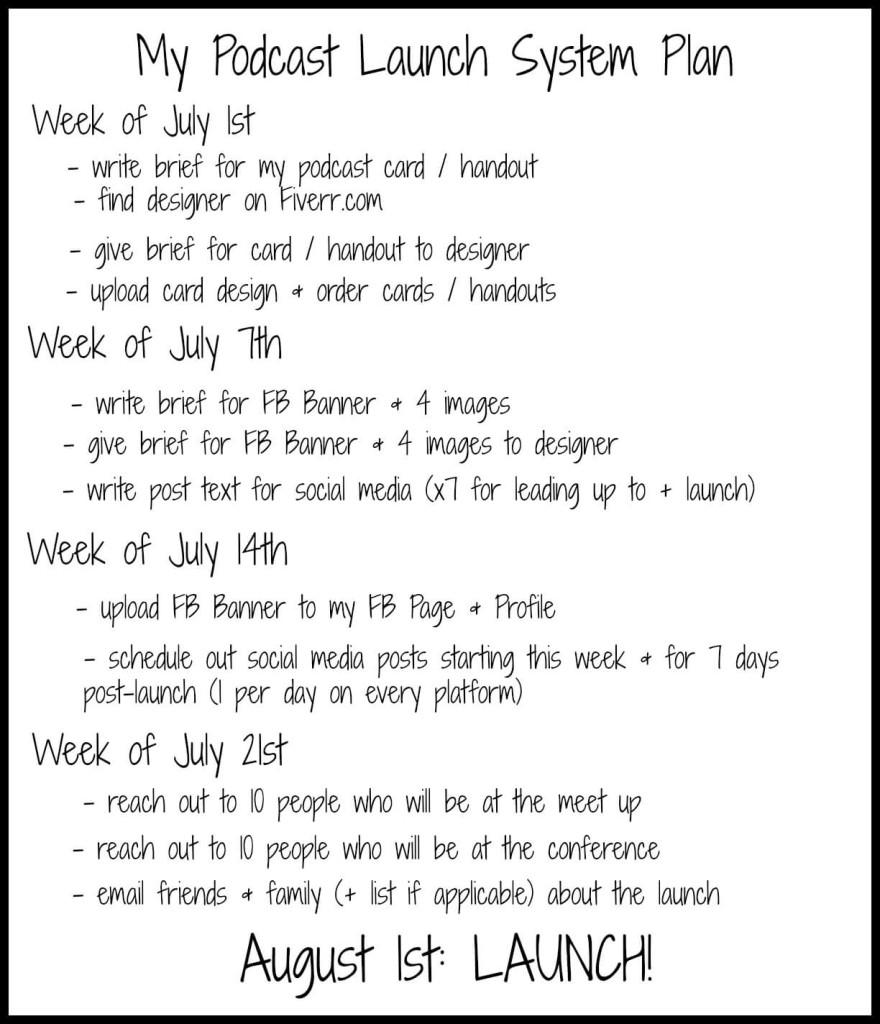
When you’re creating systems for your business, it’s likely you’re creating those systems around specific tasks and projects you’re working on.
A system for marketing and promotion
For example, rather than creating a system for your social media, which is this big massive thing you do in your business, you’re creating smaller, more specific systems for each social media platform you use – like Facebook, Twitter, etc.
This is how I’ve always broken down systems when I share the way we do it here at EOFire, sort of as a way to give more in-depth examples.
However, when I saw this comment on the post that accompanies Season 2, Episode 1, I started to think: Why haven’t I talked about systems as it relates to the bigger picture things we do in our business?

I love Casey’s question, but initially, all that was going through my head was, “How am I ever going to explain a system for something so massive?”
The bigger system
Then I realized there is a bigger system at work here – one that we follow every time we market or promote something in our business, regardless of what it is.
That said, ultimately, the smaller, individual system that is born from following the 5 steps I’m about to cover is going to be different based on what exactly you’re marketing / promoting (as Casey mentioned, she’s juggling her podcast, her website, her videos, her mentoring…), and it will also be different based on how your business is set up.
Let’s take a look at the 5 steps that make up the bigger marketing and promotion system, and then I’ll share some specifics based on Casey’s current situation.
Marketing and promotion system
Step 1: Who / what / why
The first step we always take when we’re sitting down to figure out how we’re going to market / promote something is to write out who it is we want to market / promote to.
This may or may not end up being your avatar, so make sure you spend some time figuring out who your ideal customer / consumer is.
Figuring this out is going to be based on what it is you’ve created, and putting these two things together – the who and the what – should result in you understanding and being able to communicate why it is they want what you have to offer.
Question to ask yourself: Who will find value in what it is I’ve created / have to offer and why?
Step 2: Where
Now that you know who you’re going to market / promote to and why they want what it is you’ve created, it’s time to start a list of the places you can find them.
These places will ultimately be the platforms you use to market and promote what you’ve created.
Question to ask yourself: Given who will find value in what it is I’ve created / have to offer, where can I find them?
Step 3: When
Now you know who you’re going to market / promote to, why they’re going to want it, and where you’re going to reach them.
Next comes when: the timeline.
This is going to include both the prep time and the actual marketing / promotion time, and therefore, it’s really going to depend on the specific thing you’re marketing / promoting.
For example, if it’s a one-time bigger launch for a product or service, then the time you spend preparing for the launch is going to be a lot greater than, say, if you were preparing to market / promote something like a new opt-in giveaway.
Question to as yourself: When am I going to start marketing / promoting what I’ve created (give yourself an actual hard date as a sort of deadline), and based on that, how long in advance should I start preparing?
Step 4: Assets
Once you know all the details around the who, what, when, where and why, it’s time to create the actual assets you’ll use to market / promote what you’ve created.
This will vary depending on how many places you’ll be marketing / promoting, and the specific types of marketing / promoting you’ll be doing.
For example, if you’re going to be spending a day handing out flyers, or you’ve sponsored an event and have a booth to help you market and promote what you’ve created, then you’ll need physical assets like handouts, cards, maybe a banner, and so on.
But if you’re going to only be doing marketing / promoting online, then you can probably get away with creating a couple of design options and then resizing those designs based on the individual platform requirements.
Question to ask yourself: What types of assets will I need based on the platforms I’ll be using to market / promote what I’ve created?
Step 5: Action
The last step is taking all the information you’ve gathered and all the assets you’ve created and put it into action.
Question to ask yourself: What will my marketing / promotion plan consist of based on everything I’ve learned, and what timeline will I put in place to ensure I accomplish that plan?
Breaking down the bigger system
Pretty simple, right?
Several of the 5 steps listed above will already be answered just in the pure creation of whatever it is you’re looking to market / promote, so going through these 5 steps shouldn’t be too difficult.
If you do find that going through these 5 steps is difficult, then you might revisit and focus on why you’re creating it in the first place.
One system at a time
In order to break this bigger system down so you can see how each individual system that is born from it will be different, let’s apply the 5 steps to Casey’s situation specifically.
Before I dive into one thing Casey mentioned she’s trying to marketing / promote at the moment, I will say this:
Creating systems for marketing / promotion, especially when it comes to things you’ll be marketing / promoting on a consistent, ongoing basis for your business (i.e. you’re not just prepping for a big, 1-time launch), should be implemented individually and one at a time.
So, Casey, I think that arranging your marketing / promotion systems in order of priority for your business is your first step to making this work. Of the things you mention (your podcast, your website, your videos and your mentoring), which holds priority in terms of impact for your business right now?
Remember, when we put systems in place we’re putting a recurring set of steps in order that we’re going to follow every single time we do something for our business to make doing that thing most efficient.
Once you have one system in place, you’re going to be freeing up time you can now spend on creating another system for something else.
Marketing / promotion for your podcast
Scenario A: You’re getting ready to launch a podcast – this is exciting!
Launch day is an exciting time, and just like any launch in your business, it should be treated like an event.
And what happens when we put on events? We talk about them leading up to the date, we invite people to participate and we plan out what will happen at the actual event.
We talk about them leading up to the date, we invite people to participate and we plan out what will happen at the actual event. Your podcast launch should be prepared for in the same way.
Just through the act of creating your podcast, you should already know the who / what / why and when. That is: you’re creating a podcast for your avatar, X, that will help them solve their pain point, Y, and you’re going to launch on [enter your date here] – let’s say August 1st.
What about the where, the assets and the action?
For your podcast launch, you’re going to want to put together a list of where you can find your perfect listener. That might be on Facebook in a niche group (and on Facebook in general), at a local in-person meet up, and at a conference that is coming up in July.
Given where you can find your perfect listener, your assets are likely going to consist of:
- a banner for your Facebook Page and/or profile advertising your upcoming podcast,
- 4 or 5 images and Facebook post text you can use to talk about your upcoming launch and where people can go to learn more about it,
- some type of card or handout you can bring with you to the local in-person meet up and conference you’re attending,
- an official ‘launched’ announcement you can post on social media and send out to your email list (if you have one).
Based on all the information you know about your podcast launch and the assets you’re going to need to create in order to ‘throw an event’ around your launch, what does your marketing / promotion plan look like?
Here’s an example of what your action plan might look like based on the example here:
Once you have your plan in place, then it becomes a matter of creating a process around each of the tasks and projects within your plan based on your timeline.
Create your plan, schedule specific times to work on the items you’ve listed as to-do’s, and stick to it!
For Scenario B, which touches on specifics for what a marketing / promotion system might look like on an ongoing basis for your podcast, tune in to the podcast episode above!

